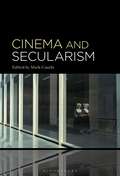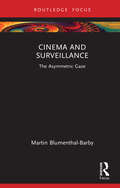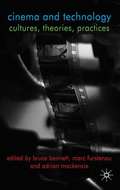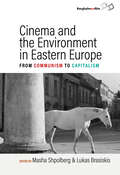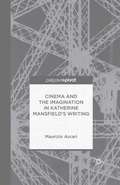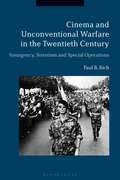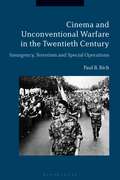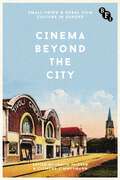- Table View
- List View
Cinema and Radio in Britain and America, 1920–60 (Studies in Popular Culture)
by Jeffrey RichardsCinema and radio in Britain and America, 1920-60 charts the evolving relationship between the two principal mass media of the period. It explores the creative symbiosis that developed between the two, including regular film versions of popular radio series as well as radio versions of hit films. This fascinating volume examines specific genres (comedy and detective stories) to identify similarities and differences in their media appearances, and in particular issues arising from the nature of film as predominantly visual and radio as exclusively aural. Richards also highlights the interchange of personnel, such as Orson Welles, between the two media. Throughout the book runs the theme of comparison and contrast between the experiences of the two media in Britain and America. The book culminates with an in-depth analysis of the media appearances of three enduring mythic figures in popular culture: Sherlock Holmes, Tarzan and The Scarlet Pimpernel. Students, scholars and lay enthusiasts of cinema history, cultural history and media studies will find this an accessible yet scholarly read.
Cinema and Secularism
by Mark CauchiCinema and Secularism is the first collection to make the relationship between cinema and secularism thematic, utilizing a number of different methodological approaches to examine their identification and differentiation across film theory, film aesthetics, film history, and throughout global cinema.The emergence of moving images and the history of cinema historically coincide with the emergence of secularism as a concept and discourse. More than historically coinciding, however, cinema and secularism would seem to have-and many contemporary theorists and critics seem to assume-a more intrinsic, almost ontological connection to each other. While early film theorists and critics explicitly addressed questions about secularism, religion, and cinema, once the study of film was professionalized and secularized in the Western academy in both film studies and religious studies, explicit and critical attention to the relationship between cinema and secularism rapidly declined. Indeed, if one canvases film scholarship today, one will find barely any works dedicated to thinking critically about the relationship between cinema and secularism. Extending the recent “secular turn” in the humanities and social sciences, Cinema and Secularism provokes critical reflection on its titular concepts. Making contributions to theory, philosophy, criticism, and history, the chapters in this pioneering volume collectively interrogate the assumption that cinema is secular, how secularism is conceived and related to cinema differently in different film cultures, and whether the world is disenchanted or enchanted in cinema. Coming from intellectually diverse backgrounds in film studies, religious studies, and philosophy, the interdisciplinary contributors to this book cover films and traditions of thought from America, Europe, Africa, the Middle East, South Asia, and East Asia. In these ways, Cinema and Secularism opens new areas of inquiry in the study of film and contributes to the ongoing interrogation of secularism more broadly.
Cinema and Secularism
Cinema and Secularism is the first collection to make the relationship between cinema and secularism thematic, utilizing a number of different methodological approaches to examine their identification and differentiation across film theory, film aesthetics, film history, and throughout global cinema.The emergence of moving images and the history of cinema historically coincide with the emergence of secularism as a concept and discourse. More than historically coinciding, however, cinema and secularism would seem to have-and many contemporary theorists and critics seem to assume-a more intrinsic, almost ontological connection to each other. While early film theorists and critics explicitly addressed questions about secularism, religion, and cinema, once the study of film was professionalized and secularized in the Western academy in both film studies and religious studies, explicit and critical attention to the relationship between cinema and secularism rapidly declined. Indeed, if one canvases film scholarship today, one will find barely any works dedicated to thinking critically about the relationship between cinema and secularism. Extending the recent “secular turn” in the humanities and social sciences, Cinema and Secularism provokes critical reflection on its titular concepts. Making contributions to theory, philosophy, criticism, and history, the chapters in this pioneering volume collectively interrogate the assumption that cinema is secular, how secularism is conceived and related to cinema differently in different film cultures, and whether the world is disenchanted or enchanted in cinema. Coming from intellectually diverse backgrounds in film studies, religious studies, and philosophy, the interdisciplinary contributors to this book cover films and traditions of thought from America, Europe, Africa, the Middle East, South Asia, and East Asia. In these ways, Cinema and Secularism opens new areas of inquiry in the study of film and contributes to the ongoing interrogation of secularism more broadly.
Cinema and Surveillance: The Asymmetric Gaze (Routledge Focus on Film Studies)
by Martin Blumenthal-BarbyCinema and Surveillance: The Asymmetric Gaze shows how key modern filmmakers challenge and disturb the relation between film and surveillance, medium and message. Assembling readings of films by Harun Farocki, Michael Haneke, and Fritz Lang, the book considers surveillance in such different domains as urban life, religious doctrine, and law enforcement. With surveillance present in the modern world as both a technological phenomenon and a social practice, the author shows how cinema, as a visual medium, presents highly sophisticated analyses of surveillance. He suggests that “surveillance” is less an issue to be tackled from a secure spectatorial position than an experience to be rendered, an event to be dealt with. Far from offering a general model of spectatorship, the book explores how narrative moments of surveillance are complicated by specific spectatorial responses.In its intersection of well-known figures and a highly topical issue, this book will have broad appeal, especially, but not exclusively, among students and scholars in film studies, media studies, German studies, European studies, art history, and political theory.
Cinema and Surveillance: The Asymmetric Gaze (Routledge Focus on Film Studies)
by Martin Blumenthal-BarbyCinema and Surveillance: The Asymmetric Gaze shows how key modern filmmakers challenge and disturb the relation between film and surveillance, medium and message. Assembling readings of films by Harun Farocki, Michael Haneke, and Fritz Lang, the book considers surveillance in such different domains as urban life, religious doctrine, and law enforcement. With surveillance present in the modern world as both a technological phenomenon and a social practice, the author shows how cinema, as a visual medium, presents highly sophisticated analyses of surveillance. He suggests that “surveillance” is less an issue to be tackled from a secure spectatorial position than an experience to be rendered, an event to be dealt with. Far from offering a general model of spectatorship, the book explores how narrative moments of surveillance are complicated by specific spectatorial responses.In its intersection of well-known figures and a highly topical issue, this book will have broad appeal, especially, but not exclusively, among students and scholars in film studies, media studies, German studies, European studies, art history, and political theory.
Cinema And Technology: Cultures, Theories, Practices (PDF)
by Bruce Bennett Marc Furstenau Adrian MacKenzieThrough the analysis of examples that range from cutting-edge Hollywood blockbusters to viral films on the internet, and from Victorian cinema to the present, the contributors to this volume discuss the ways in which thinking about technology is crucial to understanding cinema's forms, significance and impact upon audiences.
Cinema and the Algerian War of Independence: Culture, Politics, and Society (Palgrave Studies in Arab Cinema)
by Ahmed BedjaouiThe book examines the war of images between France and Algeria. Discussing the role of the United States during the war, it covers topics such the presence of American reporters in Algeria, John F. Kennedy’s support for Algerian independence while a senator, the broadcasting of documentaries on the Algerian war on public television, and reporting in the press. Even half a century after Algerian independence, there remains a need for both film and literature on the war from both sides of the Mediterranean. This might seem surprising, particularly to media professionals, given the quantity of output on the subject, but both French and Algerian portrayals of the war remain flawed and shackled to their respective ideologies.The generation of FLN leaders recognized early on the importance of images, and established a clandestine film structure that would bring the Algerian cause to the world stage.The book offers an insightful and timely contribution not just to the field of North African studies but also to other disciplines, such as film and media studies, anthropology, history, journalism, and political science. Providing a rich source of research topics and viable ideas for film and documentary projects, it is a must-read for students, scholars and media professionals alike.
Cinema and the Cultural Cold War: US Diplomacy and the Origins of the Asian Cinema Network (The United States in the World)
by Sangjoon LeeCinema and the Cultural Cold War explores the ways in which postwar Asian cinema was shaped by transnational collaborations and competitions between newly independent and colonial states at the height of Cold War politics. Sangjoon Lee adopts a simultaneously global and regional approach when analyzing the region's film cultures and industries. New economic conditions in the Asian region and shared postwar experiences among the early cinema entrepreneurs were influenced by Cold War politics, US cultural diplomacy, and intensified cultural flows during the 1950s and 1960s. By taking a closer look at the cultural realities of this tumultuous period, Lee comprehensively reconstructs Asian film history in light of the international relationships forged, broken, and re-established as the influence of the non-aligned movement grew across the Cold War.Lee elucidates how motion picture executives, creative personnel, policy makers, and intellectuals in East and Southeast Asia aspired to industrialize their Hollywood-inspired system in order to expand the market and raise the competitiveness of their cultural products. They did this by forming the Federation of Motion Picture Producers in Asia, co-hosting the Asian Film Festival, and co-producing films. Cinema and the Cultural Cold War demonstrates that the emergence of the first intensive postwar film producers' network in Asia was, in large part, the offspring of Cold War cultural politics and the product of American hegemony.Film festivals that took place in cities as diverse as Tokyo, Singapore, Hong Kong, and Kuala Lumpur were annual showcases of cinematic talent as well as opportunities for the Central Intelligence Agency to establish and maintain cultural, political, and institutional linkages between the United States and Asia during the Cold War. Cinema and the Cultural Cold War reanimates this almost-forgotten history of cinema and the film industry in Asia.
Cinema and the Environment in Eastern Europe: From Communism to Capitalism
by Masha Shpolberg and Lukas BrasiskisThe annexation of Eastern Europe to the Soviet sphere after World War II dramatically reshaped popular understandings of the natural environment. With an eco-critical approach, Cinema and the Environment in Eastern Europe breaks new ground in documenting how filmmakers increasingly saw cinema as a tool to critique the social and environmental damage of large-scale projects from socialist regimes and newly forming capitalist presences. New and established scholars with backgrounds across Europe, the United States, and Australia come together to reflect on how the cultural sphere has, and can still, play a role in redefining our relationship to nature.
Cinema and the Environment in Eastern Europe: From Communism to Capitalism
by Masha Shpolberg Lukas BrasiskisThe annexation of Eastern Europe to the Soviet sphere after World War II dramatically reshaped popular understandings of the natural environment. With an eco-critical approach, Cinema and the Environment in Eastern Europe breaks new ground in documenting how filmmakers increasingly saw cinema as a tool to critique the social and environmental damage of large-scale projects from socialist regimes and newly forming capitalist presences. New and established scholars with backgrounds across Europe, the United States, and Australia come together to reflect on how the cultural sphere has, and can still, play a role in redefining our relationship to nature.
Cinema and the Environment in Eastern Europe: From Communism to Capitalism
The annexation of Eastern Europe to the Soviet sphere after World War II dramatically reshaped popular understandings of the natural environment. With an eco-critical approach, Cinema and the Environment in Eastern Europe breaks new ground in documenting how filmmakers increasingly saw cinema as a tool to critique the social and environmental damage of large-scale projects from socialist regimes and newly forming capitalist presences. New and established scholars with backgrounds across Europe, the United States, and Australia come together to reflect on how the cultural sphere has, and can still, play a role in redefining our relationship to nature.
Cinema and the Imagination in Katherine Mansfield's Writing
by M. AscariUsing silent cinema as a critical lens enables us to reassess Katherine Mansfield's entire literary career. Starting from the awareness that innovation in literature is often the outcome of hybridisation, this book discusses not only a single case study, but also the intermedia exchanges in which literary modernism at large is rooted.
Cinema and the Second Sex: Women's Filmmaking in France in the 1980s and 1990s (Film Studies: Bloomsbury Academic Collections)
by Carrie Tarr Brigitte RolletWomen's filmmaking in France has been a source of both delight and despair. On the one hand, the numbers are impressive – over 250 feature-length films were made by over 100 women directors in France in the 1980s and 1990s. On the other hand, despite the heritage of French feminism, French women directors characteristically disclaim their gender as a significant factor in their filmmaking. This incisive study provides an informative, critical guide to this major body of work, exploring the boundaries between personal films (intimate psychological dramas relating to key stages in life) and genre films (which demonstrate women's ability to appropriate and rework popular genres). It analyzes the effects of postfeminism, women's desire to enter the mainstream, and the impact of a new generation of filmmakers, enabling readers to take stock of the wealth and diversity of women's contribution to French cinema during the 1980s and 1990s.
Cinema and the Swastika: The International Expansion of Third Reich Cinema
by Roel Vande Winkel and David WelchThis is the first publication to bring together comparative research on the international expansion of Third Reich cinema. This volume investigates various attempts to infiltrate - economically, politically and culturally - the film industries of 20 countries and regions either occupied by, friendly with or neutral towards Nazi Germany.
Cinema and Unconventional Warfare in the Twentieth Century: Insurgency, Terrorism and Special Operations
by Paul B. RichCinematic representations of unconventional warfare have received sporadic attention to date. However, this pattern has now begun to change with the rise of insurgency and counter-insurgency in Iraq and Afghanistan, and the growing importance of jihadist terrorism in the wake of 9/11. This ground-breaking study provides a much-needed examination of global unconventional warfare in 20th-century filmmaking, with case studies from the United States, Britain, Ireland, France, Italy and Israel. Paul B. Rich examines Hollywood's treatment of counter-terrorism and counter-insurgency in the United States; British post-colonial insurgencies in Malaya and Kenya and British special operations in the Second World War; the Irish conflict before and during the Troubles; French filmmaking and the reluctance to deal with the bitter war in Algeria in the 1950s; Italian neorealism and its impact on films dealing with urban insurgency by Roberto Rossellini, Nanni Loy and Gillo Pontecorvo, and Israel and the upsurge of Palestinian terrorism. Whilst only a small number of films on these conflicts have been able to rise above stereotyping insurgents and terrorists - in some cases due to a pattern of screen orientalism - Cinema and Unconventional Warfare in the Twentieth Century stresses the positive political gains to be derived from humanizing terrorists and terrorists movements, especially in the context of modern jihadist terrorism. This is essential reading for academics, postgraduates and advanced undergraduates interested in 20th-century military history, politics and international relations, and film studies.
Cinema and Unconventional Warfare in the Twentieth Century: Insurgency, Terrorism and Special Operations
by Paul B. RichCinematic representations of unconventional warfare have received sporadic attention to date. However, this pattern has now begun to change with the rise of insurgency and counter-insurgency in Iraq and Afghanistan, and the growing importance of jihadist terrorism in the wake of 9/11. This ground-breaking study provides a much-needed examination of global unconventional warfare in 20th-century filmmaking, with case studies from the United States, Britain, Ireland, France, Italy and Israel. Paul B. Rich examines Hollywood's treatment of counter-terrorism and counter-insurgency in the United States; British post-colonial insurgencies in Malaya and Kenya and British special operations in the Second World War; the Irish conflict before and during the Troubles; French filmmaking and the reluctance to deal with the bitter war in Algeria in the 1950s; Italian neorealism and its impact on films dealing with urban insurgency by Roberto Rossellini, Nanni Loy and Gillo Pontecorvo, and Israel and the upsurge of Palestinian terrorism. Whilst only a small number of films on these conflicts have been able to rise above stereotyping insurgents and terrorists - in some cases due to a pattern of screen orientalism - Cinema and Unconventional Warfare in the Twentieth Century stresses the positive political gains to be derived from humanizing terrorists and terrorists movements, especially in the context of modern jihadist terrorism. This is essential reading for academics, postgraduates and advanced undergraduates interested in 20th-century military history, politics and international relations, and film studies.
Cinema Anime: Critical Engagements with Japanese Animation
by Steven T. BrownThis collection charts the terrain of contemporary Japanese animation, one of the most explosive forms of visual culture to emerge at the crossroads of transnational cultural production in the last twenty-five years. The essays offer bold and insightful engagement with animé's concerns with gender identity, anxieties about body mutation and technological monstrosity, and apocalyptic fantasies of the end of history. The contributors dismantle the distinction between 'high' and 'low' culture and offer compelling arguments for the value and importance of the study of animé and popular culture as a key link in the translation from the local to the global.
Cinema At the Edges: New Encounters with Julio Medem, Bigas Luna and José Luis Guerín
by Abigail LoxhamThe works of popular Spanish film directors Julio Medem, Juan José Bigas Luna, and José Luis Guerín are newly appraised in relation to their engagement with alternative national and cinematic subjectivities. Their films examine the limitations of the cinematic gaze, as the author shows, highlighting the ways in which these directors make recourse to hybridity, contact, and interface to overcome the binary power dynamic previously thought to be a feature of cinema. This book explores their status as solely “Spanish” filmmakers while focusing on their diverse and immensely creative output, offering new readings that engage with current debates in visual culture surrounding psychoanalytic theory, phenomenology, and theories of documentary practice.
Cinema Beyond Territory: InFlight Entertainment and Atmospheres of Globalization (Cultural Histories of Cinema)
by Stephen GroeningIn this groundbreaking exploration of in-flight cinema, Stephen Groening traces the history of this transnational cinematic practice. At once a history of exhibition and an inquiry into changing forms of media and spectatorship, this interdisciplinary book opens up new directions in the history of cinema, visuality, travel and cultural geography.
Cinema Beyond Territory: InFlight Entertainment and Atmospheres of Globalization
by Stephen GroeningIn this groundbreaking exploration of in-flight cinema, Stephen Groening traces the history of this transnational cinematic practice. At once a history of exhibition and an inquiry into changing forms of media and spectatorship, this interdisciplinary book opens up new directions in the history of cinema, visuality, travel and cultural geography.
Cinema Beyond the City (Cultural Histories of Cinema)
by Judith Thissen Clemens ZimmermannCinema is often perceived as a metropolitan medium – an entertainment product of the big city and for the big city. Yet film exhibitors have been bringing moving pictures to towns and villages since the early days of itinerant shows. This volume presents for the first time an exploration of the social, cultural and economic dynamics of film culture in the European countryside. Spanning more than a century of film exhibition from the early twentieth-century to the present day, Cinema Beyond the City examines the role that movie-going has played in small-town and rural communities across Europe. It documents an amazing diversity of sites and situations that are relevant for understanding historical and current patterns in film consumption. In chapters written by leading scholars and young academics, interdisciplinary research is used to address key questions about access, economic viability, audience behaviour, film programming and the cultural flows between cities and hinterlands. With its wide range of regional studies and innovative methodological approaches, the collection will be of interest not only to film historians, but also to scholars in the fields of urban history, rural studies and cultural geography.
Cinema Beyond the City: Small-town And Rural Film Culture In Europe (Cultural Histories of Cinema)
by Judith Thissen Clemens ZimmermannCinema is often perceived as a metropolitan medium – an entertainment product of the big city and for the big city. Yet film exhibitors have been bringing moving pictures to towns and villages since the early days of itinerant shows. This volume presents for the first time an exploration of the social, cultural and economic dynamics of film culture in the European countryside. Spanning more than a century of film exhibition from the early twentieth-century to the present day, Cinema Beyond the City examines the role that movie-going has played in small-town and rural communities across Europe. It documents an amazing diversity of sites and situations that are relevant for understanding historical and current patterns in film consumption. In chapters written by leading scholars and young academics, interdisciplinary research is used to address key questions about access, economic viability, audience behaviour, film programming and the cultural flows between cities and hinterlands. With its wide range of regional studies and innovative methodological approaches, the collection will be of interest not only to film historians, but also to scholars in the fields of urban history, rural studies and cultural geography.
The Cinema Book
by Bloomsbury PublishingThe Cinema Book is widely recognised as the ultimate guide to cinema. Authoritative and comprehensive, the third edition has been extensively revised, updated and expanded in response to developments in cinema and cinema studies. Lavishly illustrated in colour, this edition features a wealth of exciting new sections and in-depth case studies. Sections address Hollywood and other World cinema histories, key genres in both fiction and non-fiction film, issues such as stars, technology and authorship, and major theoretical approaches to understanding film.
The Cinema Book
by Bloomsbury PublishingThe Cinema Book is widely recognised as the ultimate guide to cinema. Authoritative and comprehensive, the third edition has been extensively revised, updated and expanded in response to developments in cinema and cinema studies. Lavishly illustrated in colour, this edition features a wealth of exciting new sections and in-depth case studies. Sections address Hollywood and other World cinema histories, key genres in both fiction and non-fiction film, issues such as stars, technology and authorship, and major theoretical approaches to understanding film.
Cinéma brut: Eine alternative Genealogie der Filmavantgarde (Edition Angewandte)
by Gabriele JutzBis heute schwingt im Begriff der Filmavantgarde der Gedanke mit, ein Film sei umso avantgardistischer, je „reiner" er sei - je mehr er seine medienspezifische Bedingtheit, seine "Essenz" inszeniere und sich von anderen Künsten „befreie". Diesem modernistischen Diskurs des Purismus, der sich auch in der aktuellen post-medium condition hartnäckig hält, antwortet die vorliegende Studie mit einer alternativen Phänomenologie und Genealogie des Avantgardefilms, die nicht das Reine, sondern das „Unreine" zum Maßstab nimmt. Mit der expanded-cinema-Aktion, dem handmade- und dem found-footage-Film stellt die Autorin dem cinéma pur ein cinéma brut gegenüber, dessen Dispositive und Praktiken sich am Schmutzigen, an Formverlust und Grenzüberschreitung orientieren. Ausgehend von kunst- und kulturtheoretischen Debatten um Materialität und Performanz, Index und Spur, werden zunächst Grundzüge des cinéma brut systematisiert, und in einem zweiten Schritt, anhand exemplarischer Analysen, Eckpunkte einer „unreinen" Geschichte der europäischen und nordamerikanischen Filmavantgarde markiert.

